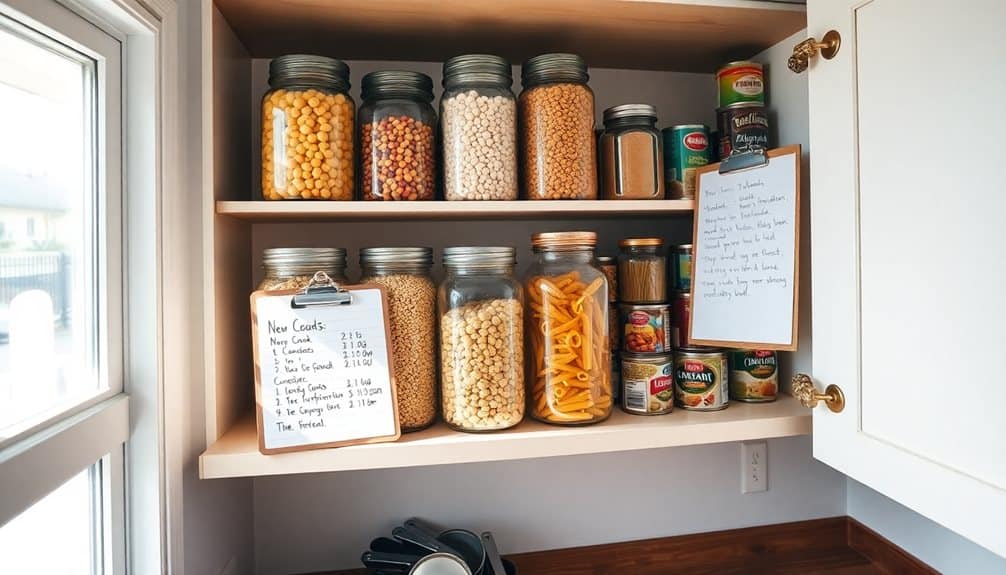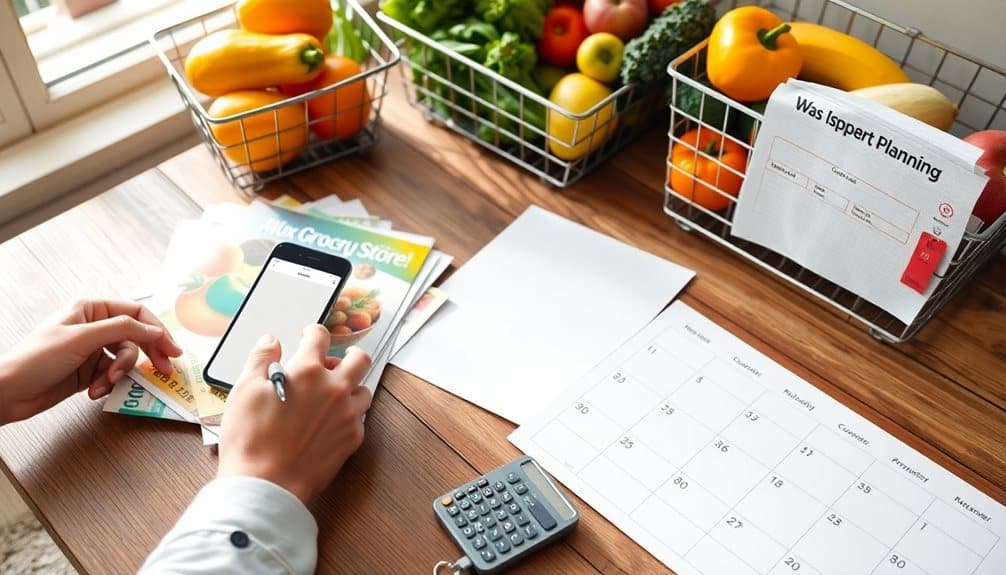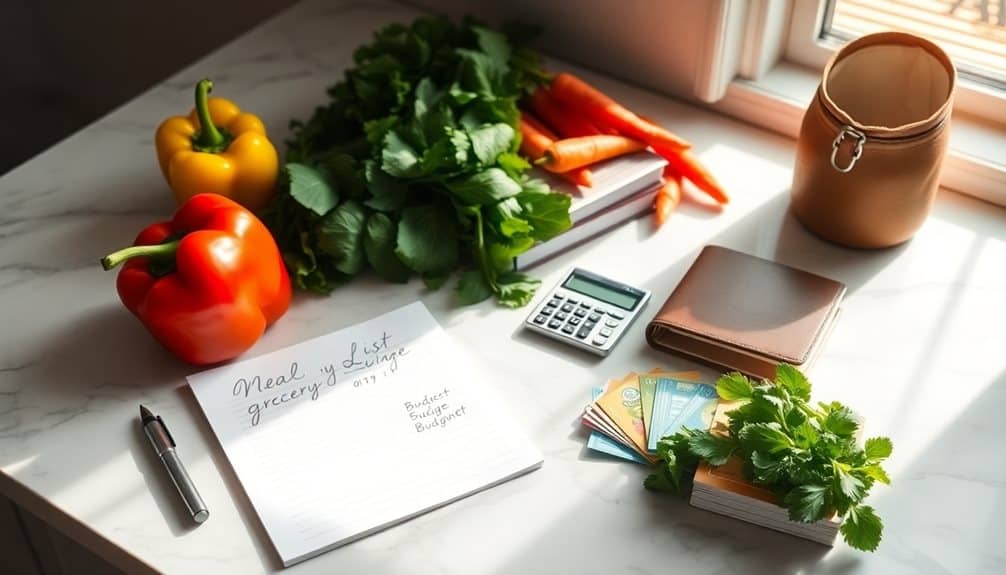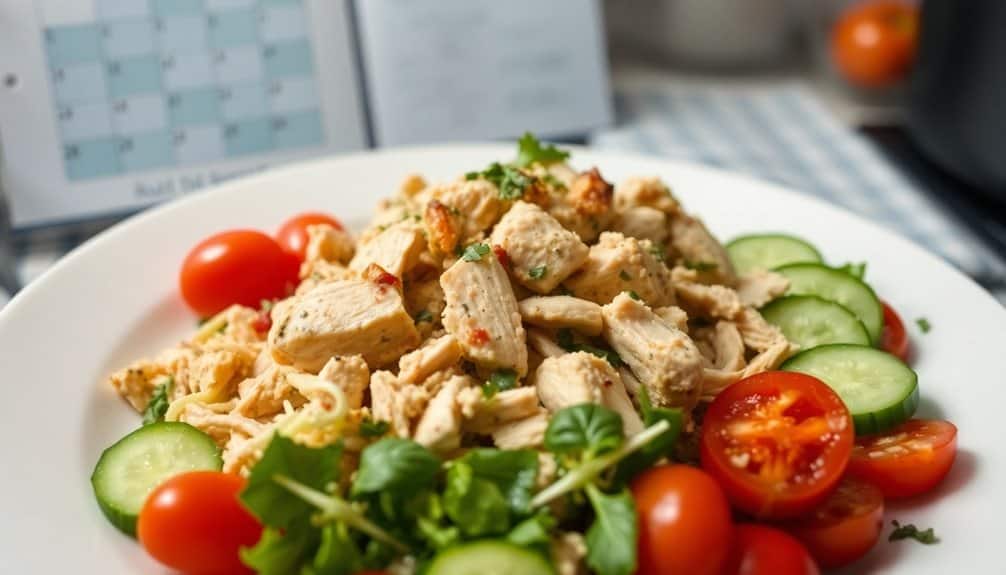This website contains affiliate links. Some products are gifted by the brand to test. As an Amazon Associate, I earn from qualifying purchases. The content on this website was created with the help of AI.
You’ll transform your grocery budget and eating habits with these five essential steps to frugal meal planning. Start by taking inventory of your pantry to avoid duplicate purchases. Next, align your weekly menu with store sales and seasonal deals to maximize savings. Create detailed shopping lists organized by store layout, and stick to them religiously. Implement batch cooking sessions to prep ingredients and complete meals in advance. Finally, master the art of repurposing leftovers into creative new dishes. These proven strategies will help you cut food costs by 20-30% while enjoying healthier, home-cooked meals. Discover how each step builds upon the next to create a sustainable meal planning system.
Key Takeaways
- Take inventory of your pantry, freezer, and fridge contents to avoid duplicate purchases and plan meals around existing ingredients.
- Study weekly sales circulars and store promotions to build your meal plan around discounted ingredients and seasonal deals.
- Create detailed shopping lists organized by store layout, including specific quantities to prevent overbuying and food waste.
- Dedicate time for batch cooking and ingredient preparation to save money on convenience foods and reduce weekday stress.
- Transform leftovers into new meals by repurposing ingredients creatively, maximizing your food budget and minimizing waste.
Take Stock of Your Pantry

Before creating your meal plan, thoroughly assess your pantry, refrigerator, and freezer contents to identify what ingredients you already have. Create a detailed inventory list, categorizing items by type (grains, proteins, vegetables) and noting their expiration dates. This practice helps prevent food waste and unnecessary purchases while maximizing your existing resources.
Check your staple ingredients like rice, pasta, beans, and canned goods, which form the foundation of many budget-friendly meals. Don’t forget to inspect your spices and seasonings, as these can greatly impact your meal variety without additional cost. If you find items nearing their expiration date, prioritize these in your upcoming meal plan.
Organize your storage spaces as you conduct the inventory, grouping similar items together and moving older products to the front. This system guarantees you’ll use items before they spoil and helps maintain an accurate understanding of your available ingredients. Keep your inventory list updated, perhaps using a digital note-taking app or spreadsheet, so you can reference it while grocery shopping or meal planning. This systematic approach reduces duplicate purchases and helps maintain a cost-effective kitchen.
Plan Around Weekly Sales

Building upon your pantry inventory, researching weekly sales at local grocery stores becomes your next money-saving strategy. You’ll want to review weekly circulars or digital apps from multiple stores to identify the best deals on fresh produce, proteins, and pantry staples. This targeted approach helps you reduce your grocery spending while maintaining nutritional quality in your meals.
Create a strategic shopping plan by focusing on seasonal items and loss leaders – those deeply discounted products stores use to attract customers. You’ll maximize savings by planning your weekly menu around these sales rather than starting with recipes and buying ingredients at full price.
- Download store apps and sign up for loyalty programs to access digital coupons and exclusive deals
- Compare prices across 2-3 local stores, factoring in travel costs and time
- Stock up on non-perishable items when they’re greatly discounted, but only if they’re part of your regular meal rotation
When you align your meal planning with sales cycles, you’ll typically save 20-30% on your grocery budget while still preparing nutritious, varied meals for your household. Using clear storage containers in your refrigerator can help you easily track your purchased sale items and reduce food waste through better visibility.
Create Your Shopping List

A well-organized shopping list forms the foundation of successful budget meal planning. Start by categorizing your items according to your store’s layout – produce, proteins, pantry staples, and dairy. This systematic approach saves time and prevents impulse purchases that can derail your budget.
Cross-reference your meal plan with your current pantry inventory to identify exactly what you need. List specific quantities for each item, guaranteeing you’ll have enough ingredients for planned meals while avoiding excess that could spoil. Include alternative ingredients when possible, allowing flexibility if you encounter unexpected price changes or availability issues.
Document your list digitally using a smartphone app or keep a running list throughout the week as you deplete items. Pay special attention to seasonal produce and sale items you’ve identified in store circulars. Calculate estimated costs for each item to stay within your budget parameters and prioritize essential ingredients over optional ones.
Before finalizing your list, review it to eliminate unnecessary items and confirm all components of your planned meals are included. Remember to factor in portions sizes and any planned leftovers when determining quantities.
Cook Smart and Batch Prep

Strategic batch cooking maximizes your time and budget while guaranteeing nutritious meals throughout the week. By dedicating 2-3 hours on a weekend, you’ll reduce weekday stress and minimize the temptation to order takeout. Focus on versatile ingredients that can be repurposed across multiple dishes, such as roasted vegetables, whole grains, and lean proteins.
When batch cooking, follow these evidence-based practices:
- Cook proteins in bulk – roast a whole chicken, prepare lean ground turkey, or bake fish fillets. Portion and refrigerate for 3-4 days, or freeze for up to 3 months.
- Prep vegetables efficiently – wash, chop, and roast multiple sheet pans of seasonal vegetables. Store in airtight containers to maintain freshness and nutrients.
- Prepare nutrient-dense bases – cook quinoa, brown rice, or legumes in large quantities. These complex carbohydrates maintain their quality when properly stored and provide essential fiber and minerals.
Store your prepped ingredients in clear, labeled containers with dates. Organize your refrigerator with older items in front to guarantee proper food rotation and minimize waste. You’ll find that smart batch cooking reduces your grocery expenses while supporting healthy eating habits. Consider using coconut coir bedding in your kitchen compost bin to efficiently process food scraps and create nutrient-rich soil for a home garden.
Repurpose Your Leftovers

Transform your leftovers into entirely new meals to stretch your food budget and reduce waste. You’ll maximize your grocery investment while maintaining nutritional variety in your diet. Studies show that repurposing leftovers can reduce household food waste by up to 25% and save families an average of $1,500 annually.
Create protein-rich grain bowls by combining leftover rice with roasted vegetables and adding a fresh protein source. Turn yesterday’s chicken into today’s filling for tacos, wraps, or a hearty salad. Blend surplus vegetables into nutrient-dense soups, or incorporate them into frittatas and stir-fries. Stale bread becomes homemade croutons or breadcrumbs for future recipes.
Store your leftovers properly to maintain food safety and quality. Use airtight containers and refrigerate within two hours of cooking. Label containers with contents and dates, and consume refrigerated leftovers within 3-4 days. For longer storage, freeze portions in measured amounts. When reheating, verify food reaches 165°F (74°C) to eliminate potential bacteria. Keep a running inventory of your stored leftovers to plan subsequent meals effectively. Consider using storage bins to organize leftovers by category in your refrigerator, making meal planning more efficient.
Frequently Asked Questions
How Long Can Homemade Freezer Meals Safely Last in Storage?
You’ve just prepared a big batch of homemade lasagna for freezing, and you’re wondering about its shelf life. In a properly functioning freezer set at 0°F (-18°C), your meals can safely last 3-6 months. Ground meats stay fresh for 3-4 months, while whole cuts can last 4-6 months. You’ll get best quality if you use airtight containers or heavy-duty freezer bags and remove as much air as possible.
What Kitchen Tools Are Essential for Budget-Friendly Meal Preparation?
You’ll need a sharp chef’s knife, cutting board, large stockpot, sheet pan, colander, food storage containers, measuring cups/spoons, and mixing bowls as essential tools. A slow cooker or pressure cooker can multiply your savings by transforming cheaper cuts of meat into tender meals. Don’t forget a quality can opener, vegetable peeler, and grater for basic prep work.
Should I Buy Organic Produce When Trying to Save Money?
While organic produce offers fewer pesticides, conventional fruits and vegetables can be a smart financial choice when you’re budgeting. Focus on the “Clean Fifteen” and “Dirty Dozen” lists to make strategic organic purchases. Buy conventional for thick-skinned produce like avocados and bananas, but consider organic for items like strawberries and spinach that absorb more pesticides. You’ll get nutritional benefits either way while saving money where it matters most.
How Do I Calculate the Cost per Serving of Homemade Meals?
To calculate cost per serving, add up the prices of all ingredients used in your recipe, including small amounts of pantry staples like oil and spices. Divide the total by the number of servings the recipe yields. Don’t forget to account for actual amounts used – if you only use 1/4 cup of a $4 container of broth, you’ll count $1 for that ingredient’s portion in your meal.
Which Ingredients Should I Avoid Buying in Bulk to Prevent Waste?
Don’t buy fresh herbs, leafy greens, and delicate produce in bulk unless you’ll use them within 3-5 days. Avoid bulk purchases of specialty spices, nuts, and whole grains that you rarely use, as they can turn rancid. You’ll also want to limit bulk purchases of dairy products, bread, and fresh meat unless you have adequate freezer space and plan to portion and freeze them immediately.




